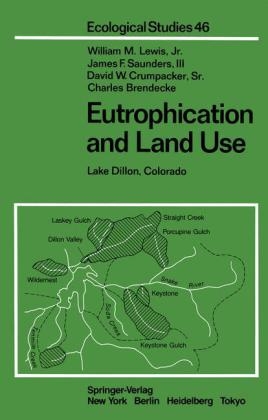
Eutrophication and Land Use, Lake Dillon, Colorado
Springer-Verlag New York Inc. (Hersteller)
978-0-387-90961-5 (ISBN)
- Titel ist leider vergriffen;
keine Neuauflage - Artikel merken
1. Introduction.- 2. Design of the Study.- Time Series Data Set.- Spatial Survey Series.- Special Studies.- 3. Methods.- Lake and Stream Sample Collection.- Filtration and Analysis of Particulates.- Phosphorus Analysis.- Soluble Nitrogen Analysis.- pH, Alkalinity, Oxygen, and Major Ions.- Chlorophyll a.- Phytoplankton and Zooplankton.- Primary Production.- Temperature, Conductance, and Transparency.- Discharge Measurements.- Precipitation Sampling.- Special Studies.- Precision and Accuracy.- 4. Physical Variables and Major Ion Chemistry of the Lake.- Geology.- Morphometry.- Hydrology.- Temperature.- Transparency.- Historical Changes in Transparency.- Composition of Major Ions.- Conductance.- pH and Alkalinity.- 5. Phosphorus and Nitrogen in Lake Water and Sediments.- Phosphorus in Lake Water.- Nitrogen in Lake Water.- Sediment Phosphorus.- 6. Particulates and Phytoplankton Biomass.- Total Particulates in the Water Column.- Chlorophyll a.- Phytoplankton Composition and Seasonality.- Elemental Composition of Phytoplankton Biomass.- 7. Zooplankton.- 8. Photosynthesis and Oxygen Consumption in the Water Column.- Photosynthesis.- Oxygen Concentrations and Oxygen Consumption.- 9. Nutrient Enrichment Studies.- 10. Horizontal Spatial Variation in the Lake.- The Five-Station Heterogeneity Study.- The 14-Station Heterogeneity Study.- 11. Overview of Limnology and Throphic Status.- The Annual Cycle.- Trophic Status of the Lake.- 12. Chemistry of Nutrient Sources as They Enter the Lake.- 24-Hour Variation in River Chemistry.- Chemistry of the Three Rivers as They Enter the Lake.- Chemistry of Miner’s Creek and Soda Creek.- Frisco and Snake River Treatment Plant Effluents.- Atmospheric Deposition at the Main Station.- Precipitation Chemistry at Other Stations.- 13. Total Nutrient Loading of the Lake.- Water Budget.- Phosphorus Loading.- Nitrogen Loading.- Overview of Phosphorus and Nitrogen Loading.- 14. Nutrient Export in Relation to Land Use.- Undisturbed Watersheds.- Residential Area on Sewer.- Urban Area on Sewer.- Residential Areas on Septic Systems.- Ski Slopes.- Interstate Highways.- Mining.- Point Sources.- Overview of Nutrient Yields.- 15. Separation of Nutrient Sources within the Watershed.- Snake River Drainage.- Blue River Drainage.- Tenmile Creek Drainage.- Relationship between Runoff and Nutrient Storage.- Comparison of Observed and Predicted Total P and N Loading.- Itemization of Lake Nutrient Sources for 1981 and 1982.- 16. Modelling.- The Land Use Component of the Model.- The Trophic-Status Component of the Model.- Effects Component of the Model.- Comparing Predictions and Observations for 1981 and 1982.- 17. Using the Model for Prediction.- Model Runs for Present Land-Use Patterns.- Scenarios 1A, 1B: Low Growth.- Scenarios 2A, 2B: Low Growth with Diversions.- Scenarios 3A, 3B: High Growth.- Scenarios 4A, 4B: High Growth with Perfect Nonpoint Controls.- Scenarios 5A, 5B: High Growth with Partially Effective Nonpoint Controls.- Overview of Scenario Studies.- 18. Summary.- References.
| Zusatzinfo | Illustrations, unspecified |
|---|---|
| Verlagsort | New York, NY |
| Sprache | englisch |
| Themenwelt | Naturwissenschaften ► Biologie ► Ökologie / Naturschutz |
| Technik ► Umwelttechnik / Biotechnologie | |
| ISBN-10 | 0-387-90961-3 / 0387909613 |
| ISBN-13 | 978-0-387-90961-5 / 9780387909615 |
| Zustand | Neuware |
| Haben Sie eine Frage zum Produkt? |